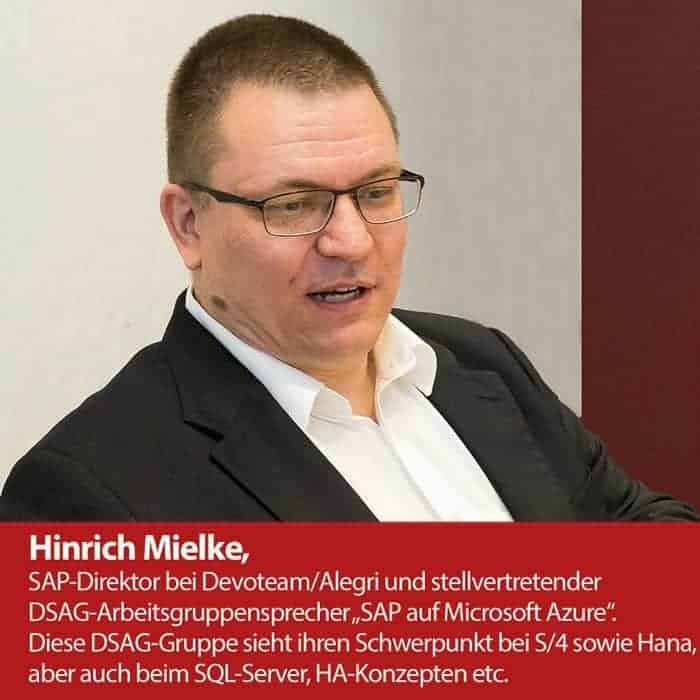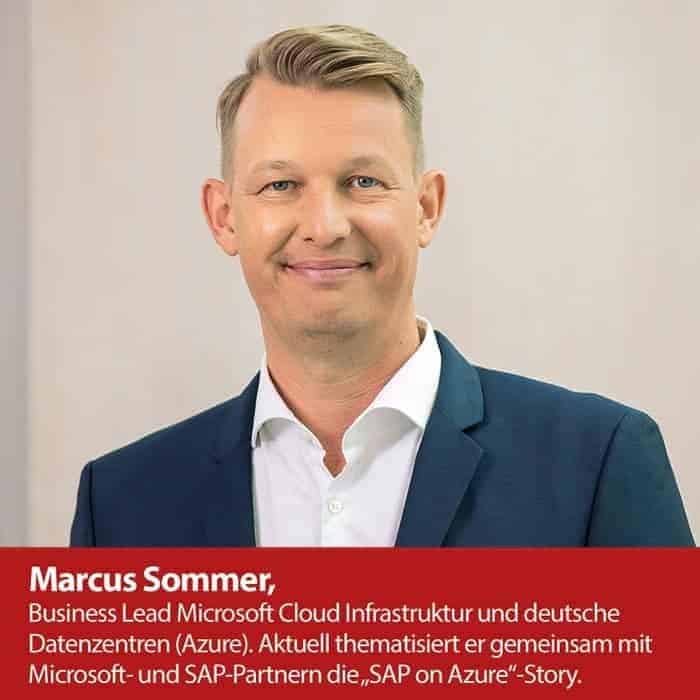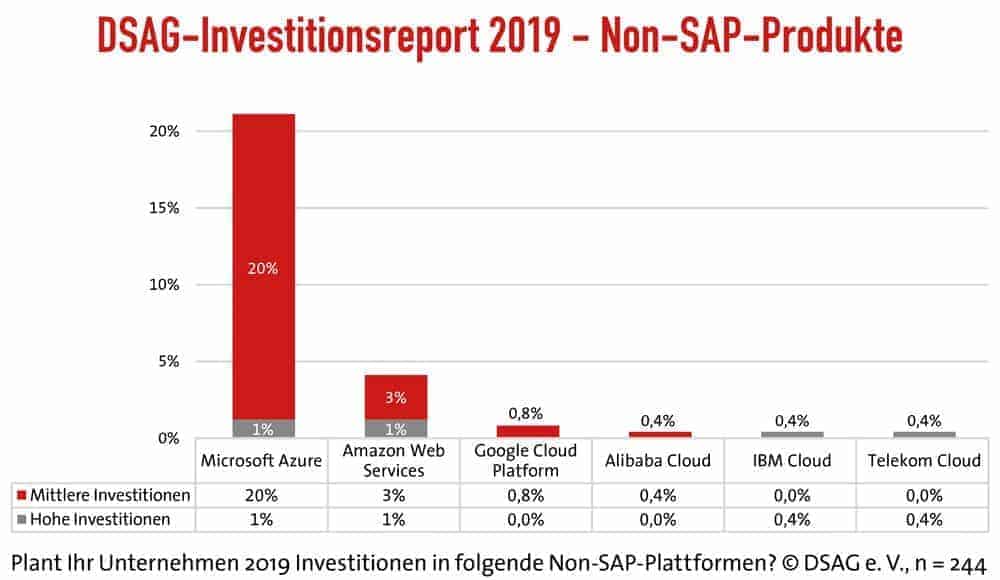Non-SAP Cloud first


According to this year's DSAG investment survey, Microsoft is the winner across the board when it comes to non-SAP platforms. The success lies in Microsoft's eco system and partner model. This community offers everything an existing SAP customer needs in terms of technology, organization and licenses for their digital transformation.
Microsoft itself has been an intensive user of SAP software for many years and has almost completely made the move to the cloud for this. Likewise SAP and Microsoft partner Devoteam/Alegri, which transformed its financial system to S/4 and Hana and then brought it to Microsoft Azure. E-3 Magazine spoke with representatives of both companies about "SAP on Azure.
Mr. Mielke, the DSAG investment report from the beginning of this year shows a very high acceptance of Microsoft Azure Cloud compared to other non-SAP platforms. What is Microsoft doing better?
Hinrich Mielke: Microsoft's advantage is based on hard facts and soft factors. Due to the success of Office 365, many customers are already discussing Azure with their employees, the data protection officer and the works council.
Formal hurdles have already been overcome. Microsoft is also a major SAP customer and uses many SAP systems. These systems have already been converted to Azure to the greatest possible extent - and Microsoft is also communicating this to the outside world in a correspondingly competent and open manner.
Here we come to the soft factors: In my perception, Microsoft is addressing the enterprise sector competently and investing here.
Both in experienced employees who speak the customer's language and in appropriate public relations. Microsoft is aware that the sales cycle in the SAP environment requires staying power, and is acting accordingly.
You are SAP Director at Devoteam/Alegri and have brought S/4 Simple Finance to the Azure Cloud, what was your experience? Where were there problems? And what is the current status?
Mielke: We started at the end of 2015 with a greenfield approach for S/4 Hana and relied on Microsoft Azure from day one to leverage the agility of IaaS. At that time, we still needed a single release from SAP.
We had exactly one technical problem: a network driver in a special setup. Here, the close cooperation between Microsoft and Suse became apparent - because the problem was solved jointly by both partners at short notice.
Where were the challenges?
Mielke: The difficulties were more in S/4, the product was still quite new at that time, the documentation expandable. This cost time and nerves in the beginning - it got better with each upgrade. Currently we are preparing the change to version 1909.
And the positively surprising thing?
Mielke: The flexibility is always impressive; over the course of the four years, we have always been able to benefit from the progress of Azure. I mean that literally - in the meantime, we are getting significantly more performance at lower prices than in 2015, which makes my CFO happy!
Customers and applicants in particular are always impressed that we can provide desired systems at short notice and also decommission them again due to IaaS.
Such short turnaround times require a rethink in system design - a design for "the next three years" is no longer necessary. Tuning and optimization make themselves positively felt in the next monthly invoice.
Mr. Sommer, among other things, you are responsible for the "SAP on Azure" story in German-speaking countries. Looking at the DSAG investment report: Where does Microsoft's success come from?
Marcus Sommer: We must thank our customers and partners for this assessment. After all, our success is ultimately defined by our customers and partners.
So let's look at what are important factors. Firstly, it is the good interaction of our various solutions on the cloud platform, right into the very relevant hybrid area.
Here, our solutions enable good integration of existing IT landscapes with cloud-based solutions. In addition, Microsoft has always maintained intensive and long-term relationships with companies.
We therefore offer our customers a personal contact person at all times. That is not to be underestimated. But we are also backed by a powerful partner system that brings together product expertise and industry knowledge.
With this ecosystem, we therefore not only offer the technology, but also accompany the business requirements of our customers over the full lifecycle
How many Microsoft partners are there right now that can help an existing SAP customer transform from on-prem to Azure?
Summer: In Germany alone, Microsoft has a good 31,500 partners. Many of them are also SAP partners. More than 60 of these partners have already proven their SAP project and technology expertise, and my colleagues train additional partners every month.
We do this because our customers prefer to work with their existing partners. But just as important are the different competencies of our partners that I mentioned earlier. For example, we have partners who offer a managed service.
Other partners provide ready-made solutions that can be integrated into the environments and thus realize real added value in the area of cost optimization or integration. Capacity and versatility are the credo here.
How important is it for existing SAP customers that the cloud and thus the data are located in Germany?
Mielke: For many SAP customers, keeping data within the EU is very important, as is the fact that SAP operations are carried out within the EU.
Keeping data in Germany is particularly important in the regulated environment of banks or the pharmaceutical industry, and is a major plus point when deciding on an IaaS offering.
Summer: I can only emphasize that. On the one hand, there are clear legal or regulatory requirements. But customers in other industries also ask us for this and require data processing in Germany, with the full functionality of a cloud.
Our new data centers meet these requirements. They are part of our global and highly secure cloud infrastructure, but additionally guarantee the storage of customer data in Germany.
Which SAP versions will be transformed to Azure? ERP/ECC 6.0 with AnyDB? Suite on Hana? Or only S/4 Hana systems?
Mielke (laughs): There are all kinds of scenarios here. One of our customers is running out of capacity in its on-prem data center, and there are no plans for a new building - so it has to be relocated at short notice: ECC 6.0 with AnyDB.
And S/4?
Mielke: The switch to Hana with a later move to S/4 is often a triggering moment - especially for the first PoC. Here, one is often not yet sure about the sizing and the systems are also not needed 7×24.
Azure is a welcome tool for gaining initial experience with Hana. Likewise, the trust and know-how of the SAP operating team are built up with regard to Azure - and corresponding operating processes are tested, adapted and optimized.
Mr. Sommer, the SAP database Hana requires Linux as its operating system. Isn't that a contradiction for a Microsoft cloud?
Summer: On the contrary, it speaks for Azure. The incompatibility of Microsoft and open source is a relic of days gone by. We already have more Linux systems than Windows systems on Azure today.
We also maintain close partnerships with Linux distributors and are even a Platinum Member of the Linux Foundation. We do this because the choice of system is up to the customer. Even Windows 10 now has a Linux kernel.
Mr. Mielke, what has been your experience with Suse Linux on Azure in terms of installation, maintenance and performance?
Mielke: SLES for SAP on Azure is a hassle-free and well-integrated platform. With the utilities to configure and tune the OS to be SAP compliant and the live patching, reboot-free patching, the requirements of enterprise customers have been well addressed.
This is because they often cannot afford downtimes, but require systems that are demonstrably configured at an up-to-date patch level and in accordance with SAP's recommendations. As mentioned, support is integrated and exemplary.
Mr. Sommer, if an existing SAP customer wants to run their test or operational system on Azure, what Linux expertise and Linux maintenance do they need to have?
Summer: Prior knowledge of Linux never hurts. We maintain long and intensive partnerships with SAP and Linux distributors such as Suse. Together, we offer ready-made solutions here that can be deployed directly.
The SAP Cloud Appliance Library, for example, offers preconfigured systems under Suse that can be deployed on Azure for test and QA environments in a very short time. This allows you to concentrate on the essentials, such as integration into business processes.
Of course, our customers have the highest technical requirements for production systems. In addition, there are usually compliance requirements for operation. Together with Devoteam/Alegri, for example, we offer seminars on the secure operation of SAP Hana in the financial sector.
Mr. Mielke, are the resources for Linux on Azure available among SAP's existing customers? How far have S/4 users understood the "SAP on Azure" operating model?
Mielke: Running Linux on Azure is no problem for many existing SAP customers; Delta courses are available if necessary. Or the operation of Linux, Hana and, if necessary, Basis is out-tasked to us, for example.
It is important to create the architecture and operational concept as well as the system design based on a concept.
What is therefore to be considered?
Mielke: It is important to note that Microsoft Azure is a software-defined data center - and with great power comes great responsibility. A concept must be developed here, similar to the construction of a new data center.
There are proposed solutions for individual Microsoft systems, which we adapt to the customer's governance. We also help customers with the initial creation or adaptation of governance. Preliminary work that has already been done for Office 365 often helps here.
Mr. Mielke, you are also the deputy DSAG working group spokesperson "SAP on Microsoft Azure": Which topics are moving DSAG members most intensively at the moment and why?
Mielke: After all, DSAG is an association of users - and here practical experience as well as best practices from other users are currently very much in demand.
Reports on experiences, "rules of thumb" and the interactive exchange and discussion of one's own thoughts are in great demand here, which is also shown by the number of participants in the working group.
Mr. Sommer, from Microsoft's perspective, where are there still construction sites and what are the lessons learned from the transformations to date? Where will you still be providing assistance in the coming months?
Summer: Migration to the cloud is actually only the very first step. Then it's a matter of optimizing the systems and taking advantage of the new opportunities.
In other words, the automation of systems and flexible scaling in line with demand. Or shutting down systems that are not required 24×7 and offloading data that is not needed. So in the end, it's about further cost reduction.
But also integration to IoT, Office 365, inventory systems or PowerBI are topics we will increasingly address. SAP data is the basis for many other scenarios. Microsoft, for example, is already successfully using machine learning based on SAP data for its financial forecast.
Mr. Mielke, Mr. Sommer, the current discussion was mostly conducted by SAP as an "either-or". The existing SAP customer works on-prem or is in the cloud. Is that right? Does that correspond to reality?
Mielke: SAP's communication is confusing for many customers. S/4 Hana on-prem edition runs on IaaS in the cloud or on-prem. S/4 cloud edition is SaaS, has different features and a different codeline!
In reality, it will usually come down to a hybrid operation; many existing SAP customers do not want to or cannot relocate all their systems. Microsoft Azure, for example, offers a seamless transition for identities with unified management using Azure Active Directory.
Summer: Our customers make the decision when to migrate which parts to the cloud. Hardly anyone will be able to perform a complete migration in one go.
That's why it's important not to think in terms of black or white, but hybrid. And that works best with the Azure platform, because we offer uniform interfaces and systems for both on-premises and the cloud.
We offer powerful security solutions in the cloud, capable of monitoring and protecting on-prem as well as cloud systems, including third-party systems.
Mr. Sommer, the term hybrid cloud is cited and used by many SAP partners - including NetApp, with whom Microsoft has initiated joint hybrid cloud development. Can you provide information about this?
Summer: This is a fine example of one of the many strategic partnerships we maintain. Their results are incorporated into the respective products, thus enabling us to draw on existing know-how and investments.
NetApp offers various options here. On-premises and cloud can be elegantly combined. For example, cold data can be moved to the cloud using all enterprise features such as de-duplication, compression and encryption and thus optimized in terms of costs.
Mr. Mielke, how would you describe the state of knowledge in the SAP community about cloud computing in general and about public, private and hybrid cloud in particular?
Mielke: The different use of terms is confusing for many customers. At our roadshows, we always have a short session at the beginning to explain "SAP-Lingo" and sort offerings into SaaS, PaaS and IaaS and also show what exactly the scope is.
This is always gratefully accepted. The know-how about the advantages and benefits of the corresponding XaaS is definitely available - what is needed are proven procedures that lead in a structured way from the current state to the target state.
Mr. Mielke, in your S/4 transformation projects and long-standing SAP inventory customers, you probably also come across Abap modifications in the Z namespace, how do you deal with this? What is the opinion on this from the DSAG working group?
Mielke: In-house developments are an important part of the Journey to S/4 Hana or the Master Plan. An important question is whether greenfield, brownfield or one of the intermediate solutions is the way of choice; we provide neutral and independent advice on this.
Important decision criteria are the criticality of the developments, their documentation status and testability. The Readiness Check is now available in version 2.0. In addition, the Simplification List is still an important source for comparison.
After that, effort and benefit can be determined and the further procedure can be defined. Possibly one of the numerous tools on the market can help, or the greenfield approach is the solution of choice. The path to S/4 is a highly customer-specific decision.
And do you transform the entire dataset or select the data to be moved to Azure?
Mielke: Thorough housekeeping is definitely worthwhile. This goes far beyond classic archiving; for example, document types that are no longer used should also be removed beforehand.
The benefits are twofold: on the one hand, the size of the Hana database is reduced, and on the other hand, the business testing and conversion effort is reduced.
Devoteam/Alegri successfully brings existing SAP customers into the cloud. What would you like to see as further support from SAP and Microsoft?
Mielke: What I would like to see from SAP is a somewhat more stringent communication of the products, roadmaps and scope of the various offerings, including the limitations.
In addition, even more active maintenance of the partner ecosystem. SAP's service partners are the multipliers who ensure a smooth transition to S/4 and Hana.
And what is now on Microsoft's wish list?
Mielke: With Microsoft, we are almost blissfully happy - here we have worked really closely and well together over the past few years. Always important are the certified maximum sizes of virtual machines - even if customers may not need more than 8 TB of main memory now, it is always good to be able to use corresponding capacities.
Mr. Sommer, data volume is a specific issue with any S/4 transformation. You might be able to solve it with the NetApp hybrid approach. What other solutions come from the Microsoft/SAP partner network?
Summer: Here I would like to mention Datavard's ready-made solutions for innovative SAP data management as an example. Much of the data in SAP Hana is "ice cold" and volume costs money.
Our partner offers a clever solution here that recognizes this data and removes it from the active dataset. This saves costs and time and is also a good preparation for a Hana migration.
Imagine an existing SAP customer with Suite on AnyDB. SAP's 2025 deadline is approaching! How do you start the "SAP on Azure" story?
Mielke: Especially with the deadline approaching, Azure is an excellent service to start the transition quickly, flexibly and smoothly. Microsoft Azure unleashes from any hardware restrictions.
Test or project systems, even with several terabytes of main memory, can be set up and used "in the blink of an eye", e.g. even for only 50 hours per week, and can also be decommissioned again at short notice.
A trial migration to Hana can be performed and optimized in Azure without the need for dedicated hardware, with the DMO also highly parallelized if required and with minimal downtime.
Sizing with S/4 and especially with the Hana database remains a challenge, doesn't it?
Mielke: If you are not sure about the sizing of the final Hana database when merging several SAP instances into one S/4 system - no problem, you can resize the hardware within a short downtime. The barriers to entry are therefore significantly lower than on-prem, at least in terms of infrastructure.
So it's also about learning and gaining experience with S/4 in the cloud?
Summer: Many companies have had little experience with the cloud. It is a new and powerful tool. Ultimately, it takes real-world experience to arrive at a comprehensive picture.
That's why we recommend bringing a partner on board. These sometimes offer free assessments to get a complete overview of what to expect. We also offer test environments, in some cases free of charge. This is a good help to approach the topic "hands-on".







